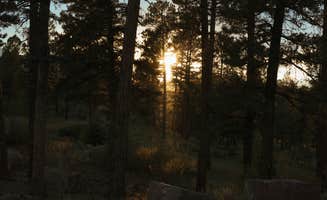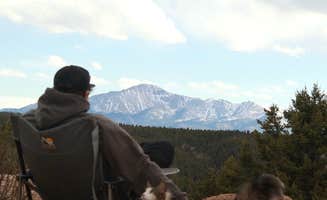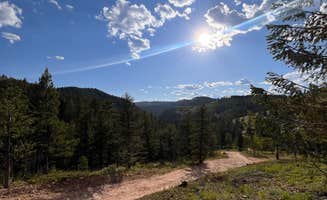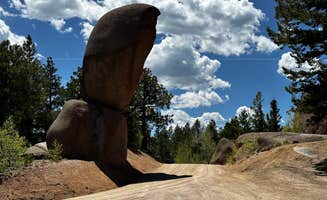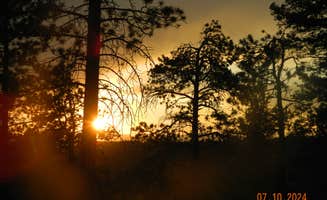Dispersed camping near Centennial, Colorado provides access to Pike National Forest with elevations typically ranging between 7,000 and 9,000 feet, creating a climate that averages 10-15 degrees cooler than Denver. Most dispersed camping areas operate seasonally from May through November, with snowfall often closing higher elevation sites by late October. The forest service roads leading to these areas vary significantly in quality and maintenance status.
What to do
Mountain biking on established trails: Buffalo Creek Recreation Area offers exceptional trail networks for various skill levels. As one camper notes, "Great camping spot, esp, if you like mountain biking... plenty of trails for various ability levels" and "Much of the area still shows scars from the 1996 fire here, but the sprouts and smaller trees show you a preview of how nature heals."
Fishing in local lakes: Beaver Park Reservoir offers fishing opportunities minutes from campsites. Visitors appreciate the "big camping spots" and note, "There are some sites that are better than others for group sizes and it isn't very RV friendly."
Wildlife viewing: Early morning and evening provide the best opportunities to observe local wildlife. At Gordon Gulch, campers report "Moose visitors at dawn and evening," though proper food storage is essential as "hungry bears scavenging for food at night is a common occurrence."
Hiking to scenic vistas: Multiple trails connect camping areas to scenic overlooks. At Rampart Range Road, campers find "lots of dispersed camping sites along the road" with "several forest service roads that branch off with dispersed camping" leading to trails with "stunning views of Pikes Peak."
What campers like
Proximity to water features: Chinns Lake provides lakefront camping spots with "access for fishing or just relaxing by the shore." One camper called it "my top 3 Colorado camping spots" while noting to be "prepared for the mosquitoes."
Private campsites: Many dispersed areas offer secluded spots away from crowds. At Redskin Creek Rd, "sites are spaced well apart, some sites are covered in trees while others are wide open" and there are "over 30 dispersed campsites along a moderately smooth dirt road."
Cell service at select locations: While most sites have limited connectivity, some areas maintain usable service. At Buffalo Creek, one visitor noted, "Few sites right off the highway with service. Fire pits and hiking near." Cell coverage typically diminishes as you travel deeper into forest areas.
Accessibility for weekend trips: Most areas are within 90 minutes of Denver, making them practical for weekend camping. One camper appreciated West Magnolia Campground for "its proximity to Nederland and Denver" calling it "a great quick spot."
What you should know
Site availability timing: Popular areas fill quickly, especially during summer weekends. At Buffalo Creek, campers report that "the area is busy and can easily fill for the weekend by Thursday mid-day" while others warn "after driving around for a couple hours ended up bailing and going home."
Road conditions vary significantly: Many access roads require appropriate vehicles. For Mount Herman Road, campers warn about "tight skinny switchbacks" where "about half way up looking for a way to turn around" becomes necessary for larger vehicles.
Seasonal closures: Higher elevation sites close with snowfall. At Chinns Lake in spring, visitors report "at least 3 feet or more of snow and ice on this trail" causing them to spend "3 hours getting unstuck."
Pack out all waste: There are no trash facilities at dispersed sites. Campers at multiple locations report finding "small pieces of plastic and glass scattered about" and having to conduct cleanup efforts, with one camper at Rampart Range Road collecting "two full grocery bags worth of garbage."
Tips for camping with families
Choose more developed dispersed areas: For families with young children, sites with established fire rings and flat tent areas work best. At Redskin Creek Rd, "sites have fire rings and plenty of room for cars and groups, most are secluded from others" making them family-friendly options.
Plan for temperature swings: Mountain elevations create significant day-to-night temperature changes, even in summer. At Cascade-Chipita Park, campers experienced "nights were cold some lows 32° and it snowed the first night" even during a late September visit.
Bring sufficient water: No water sources exist at most sites, requiring you to pack in all necessary water. Near Woodland Park, campers report finding water fill-up options where "we refilled a propane tank and filled our 6 gallon water container for $12" before heading to camp.
Check for nearby alternatives: Having backup locations prevents disappointment when primary sites are full. One family noted, "We initially planned to do disperse camping for 4 nights here but ended up having to leave early after 3 unbearable nights" due to noise and overcrowding.
Tips from RVers
Scout sites before committing: Many forest roads become progressively narrower and rougher. At Mount Herman Road, an RV owner warns, "I recently purchased a 26ft sustainable travel trailer and decided to take it out for the first time. Well the road up is very tight. Very skinny switchbacks."
Measure site slopes before setting up: Most dispersed areas lack leveled pads for RVs. Campers note that at Rampart Range Road, "Most of the sites are not flat" and "The parking areas tend to be very unlevel and there are only a few that you can pull right up to your campsite."
Choose weekday arrivals: Weekends dramatically increase competition for suitable RV spots. A camper at Buffalo Creek noted, "Sites were big and far enough away from neighbors. Would recommend," but cautioned the area "fills up very fast on the weekends."


